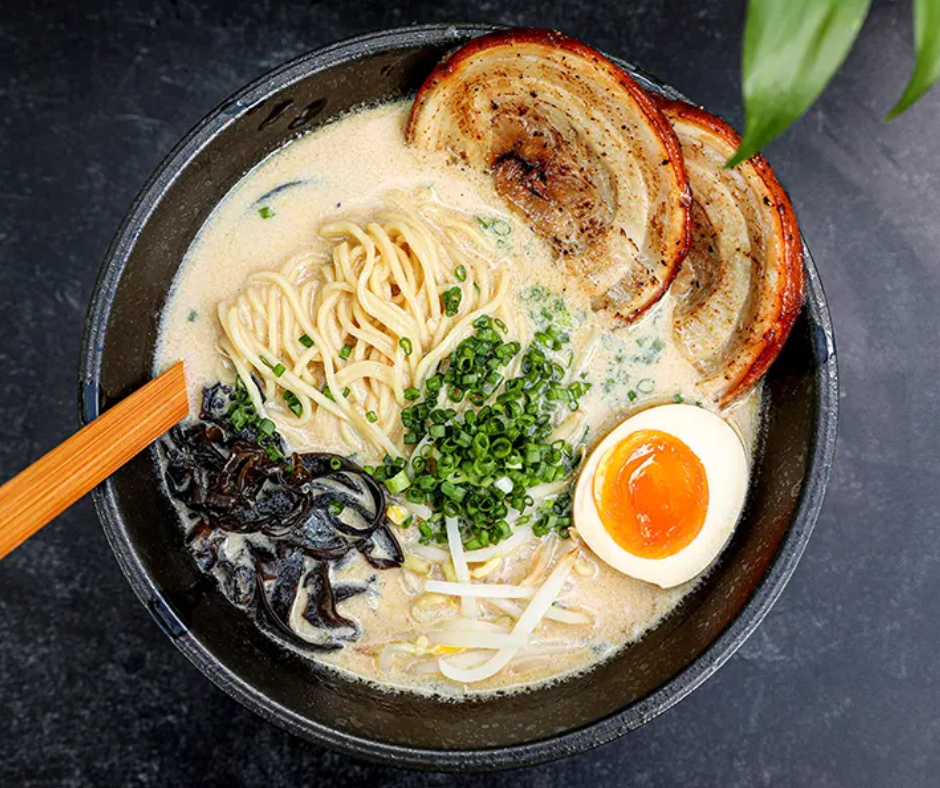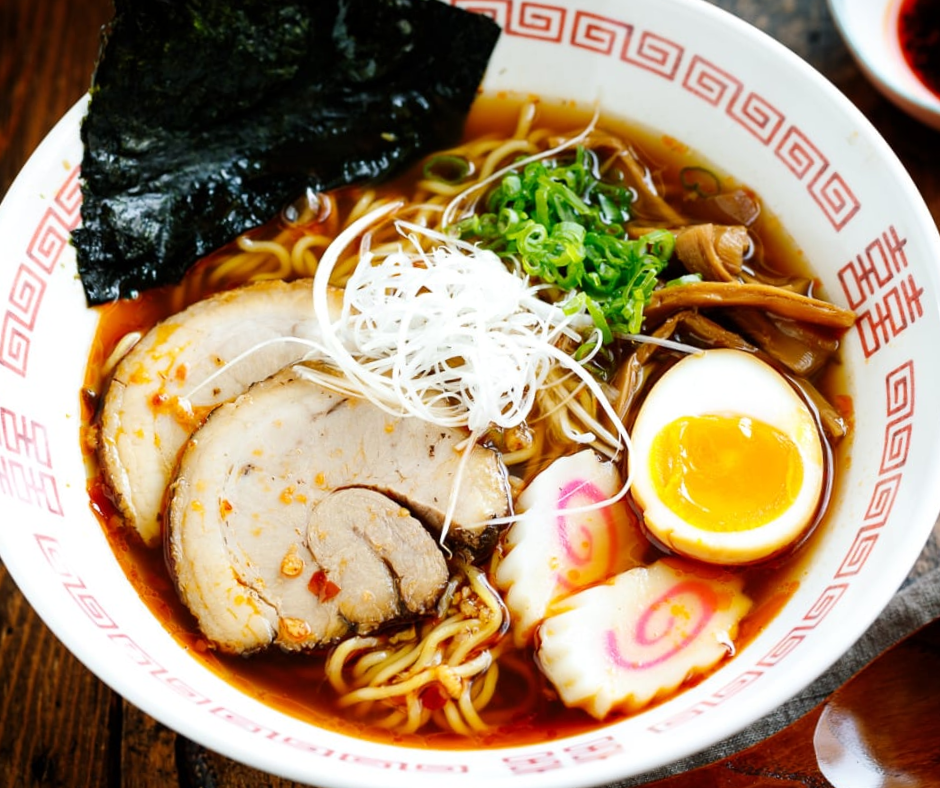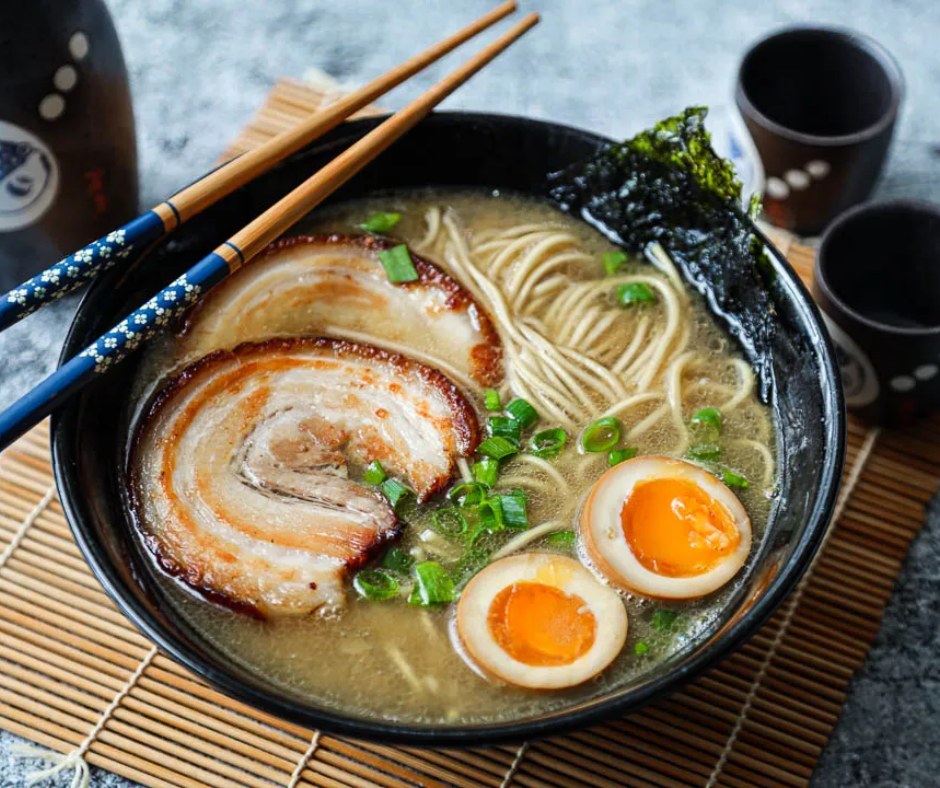Introduction
Ramen is a beloved Japanese dish that has gained popularity worldwide. With its flavorful broth and tender noodles, it’s no surprise that ramen shops have been popping up in many cities. Two popular types of ramen broths are Tonkotsu and Shoyu. This article will compare Tonkotsu vs Shoyu broths to help you understand the differences and make an informed decision.
The Popularity Of Ramen
Ramen has evolved from a humble street food to a culinary sensation. It is now enjoyed in various styles and flavors, with each region in Japan having its unique take on the dish. Ramen shops have also become a global food trend, attracting ramen enthusiasts with their mouthwatering bowls.
Different Types Of Ramen Broths
Tonkotsu: Tonkotsu broth simmers pork bones for hours until the collagen breaks down, resulting in a rich, creamy soup. It has a distinct umami flavor and a creamy texture. The broth is usually seasoned with soy sauce and topped with ingredients like chashu (braised pork), marinated soft-boiled eggs, and green onions.
Shoyu: Shoyu broth is made with soy sauce and typically has a clear, light brown color. It is made by simmering chicken, pork, or seafood with vegetables and soy sauce. Shoyu broth has a well-balanced savory taste with a hint of sweetness. It is often paired with noodles, chashu, bamboo shoots, and seaweed.
When comparing Tonkotsu vs Shoyu broths, it’s important to consider your taste preferences. Tonkotsu broth appeals to those who enjoy rich, fatty flavors, while Shoyu broth is ideal for those who prefer a lighter, more balanced taste. Both broths have their unique characteristics and are equally delicious.
In conclusion, Tonkotsu and Shoyu are two popular types of ramen broths, each with distinctive flavors. Whether you prefer the creamy richness of Tonkotsu or the balanced taste of Shoyu, trying both broths is a delightful journey for any ramen enthusiast. So, find a ramen shop near you, order a bowl, and enjoy the wonderful world of Japanese ramen!
Tonkotsu Ramen Broth
If you’re a ramen lover, you’ve probably encountered two popular broth options: tonkotsu and shoyu. Both are delicious in their own right, but they have distinct differences that set them apart. This article will focus on tonkotsu ramen broth and explore its definition, characteristics, ingredients, and cooking process.
Definition And Characteristics Of Tonkotsu Broth
Tonkotsu broth is a rich, creamy pork-based soup originating in Fukuoka, Japan. The word “tonkotsu” translates to “pork bones,” the main ingredient to create this flavorful broth. The broth is well-known for its white, opaque appearance. It is achieved by simmering pork bones for several hours until the collagen and marrow are released, creating a velvety texture and deep umami flavor.
One of the key characteristics of tonkotsu broth is its intense richness. It has a thick, almost creamy consistency with a long-lasting, savory taste that coats the palate. The broth has a bold and deep pork flavor, often accompanied by subtle hints of garlic and ginger. It is typically seasoned with soy sauce or miso to add depth and complexity to the overall taste.
Ingredients And Cooking Process
To make tonkotsu broth, you will need a few essential ingredients: pork bones, water, and aromatics such as onions, garlic, and ginger. The cooking process involves simmering the pork bones and aromatics in a large pot with water for several hours. This slow and low heat extraction method allows the collagen and marrow to break down, resulting in a rich and flavorful broth.
The broth is carefully skimmed during the cooking process to remove impurities and excess fat, resulting in a cleaner and smoother texture. Some variations of tonkotsu broth may include additional ingredients like dried mushrooms, dried fish flakes, or vegetables to enhance the flavor profile.
Once the broth is ready, it is typically served with thin noodles, tender slices of chashu pork, marinated soft-boiled eggs, and various toppings like green onions, bean sprouts, and nori (seaweed).
In conclusion, tonkotsu ramen broth is a labor of love that takes time and patience to create. Its rich, creamy, and deeply savory flavors make it a popular choice among ramen enthusiasts. So, the next time you’re in the mood for a comforting bowl of ramen, consider trying tonkotsu broth for an indulgent and satisfying experience.
Shoyu Ramen Broth
Definition And Characteristics Of Shoyu Broth
Shoyu ramen broth is a popular style used in Japanese ramen and is known for its rich and savory flavor. “Shoyu” is the Japanese word for soy sauce, and this broth gets its distinctive taste from the soy sauce used in the cooking process. The broth is typically made by combining soy sauce, dashi (a Japanese soup stock), and other seasonings such as mirin or sake. Shoyu broth has a deep, umami flavor that is both salty and slightly sweet, making it a favorite among ramen lovers.
Ingredients And Cooking Process
To make shoyu broth, you will need soy sauce, dashi stock, and additional seasonings such as mirin or sake. Dashi stock is typically made from kombu (a type of dried kelp) and katsuobushi (dried bonito flakes), simmered together to create a flavorful base. The soy sauce is then added to the dashi stock and other seasonings and simmered to infuse the flavors further.
The cooking process for shoyu broth requires time and attention to detail. The ingredients are carefully simmered for several hours to allow the flavors to meld together and create a rich, complex taste. The longer the broth simmers, the more concentrated the flavors become. Chefs may also add other ingredients, such as garlic, ginger, and onions, to enhance the overall flavor profile of the broth.
Shoyu broth is typically served with ramen noodles and various toppings such as roasted pork (chashu), green onions, bamboo shoots, and a soft-boiled egg. Combining the flavorful broth and the chewy noodles creates a delicious and satisfying bowl of ramen.
In conclusion, shoyu broth is a popular choice for ramen enthusiasts due to its rich and savory flavor. Combining soy sauce, dashi stock, and other seasonings creates a salty and slightly sweet broth with deep umami notes. The careful cooking process and selection of ingredients contribute to the overall complexity and deliciousness of the shoyu ramen broth.
Tonkotsu vs Shoyu Broth: Flavor And Texture Comparison
Richness And Creaminess Of Tonkotsu Broth
Tonkotsu broth is made by simmering pork bones for several hours until they break down and release their collagen, resulting in a thick, creamy broth. The flavor is intensely savory and packed with umami, giving it a rich and indulgent taste. The velvety smooth texture coats your palate, creating a luxurious mouthfeel.
Depth Of Flavor In Shoyu Broth
Shoyu broth, on the other hand, is made with a combination of soy sauce and other ingredients, such as fish or vegetable stock. This broth has a lighter, more delicate flavor profile compared to tonkotsu. The soy sauce adds a salty and slightly sweet taste, while other ingredients contribute to a complex and well-rounded flavor. The texture is thinner and less dense than tonkotsu, allowing the other components of the ramen, such as the noodles and toppings, to shine.
Choosing between tonkotsu and shoyu broth ultimately comes down to personal preference. If you prefer a bold and decadent flavor with a creamy texture, tonkotsu is the way to go. On the other hand, if you prefer a lighter, more nuanced flavor with a thinner broth, shoyu is a great choice.
Some ramen enthusiasts enjoy the best of both worlds by opting for a hybrid broth that combines tonkotsu and shoyu, balancing richness and depth of flavor.
To capture the essence of Tonkotsu vs Shoyu, it’s essential to use high-quality ingredients and allow sufficient cooking time for the flavors to develop. Whether you’re a tonkotsu loyalist or a shoyu specialist, the key is to savor the experience and enjoy the unique characteristics each broth brings to your bowl of ramen.
Regional Variations
Regarding ramen, two of the most popular and delicious options are tonkotsu and shoyu. Each of these broths has its unique flavor and origins, making them beloved by ramen lovers worldwide.
Tonkotsu And Shoyu In Hakata-style Ramen
In Hakata in Fukuoka, Japan, tonkotsu ramen takes the spotlight. Made from simmering pork bones for hours, tonkotsu broth is rich, creamy, and packed with umami flavors. It is typically paired with thin, straight noodles and topped with succulent slices of chashu (braised pork), green onions, and pickled ginger. The result is a hearty and satisfying bowl of ramen that will leave you wanting more.
On the other hand, shoyu ramen, also commonly found in Hakata, offers a lighter and more nuanced flavor. Shoyu, which means soy sauce in Japanese, is a key ingredient in this broth. The soy sauce adds a salty and savory taste that perfectly complements the al dente noodles and toppings. Shoyu ramen is often garnished with bamboo shoots, nori (seaweed), and a perfectly cooked soft-boiled egg.
Shoyu Ramen In Kyoto
While Hakata is known for its tonkotsu and shoyu ramen, Kyoto has its take on the latter. Kyoto-style shoyu ramen features a clear and delicate soy sauce broth lighter than the Hakata version. The broth is made by simmering chicken and vegetables for hours, resulting in a fragrant and well-balanced base. The noodles are usually thin and curly, and the toppings can vary from sliced chashu to menma (fermented bamboo shoots) and green onions.
Whether you prefer the rich and robust flavors of tonkotsu or the subtle and refined taste of shoyu, both types of ramen offer a delightful and comforting dining experience. Exploring different regional variations allows you to appreciate the diversity and creativity that can be found in this beloved Japanese dish. So, the next time you crave a steaming bowl of ramen, consider trying tonkotsu or shoyu and savoring their unique flavors.
Toppings And Accompaniments
When comparing rich ramen broths like Tonkotsu and Shoyu, the toppings and accompaniments are crucial in defining the overall flavor and experience. Let’s explore the toppings for Tonkotsu vs Shoyu ramen.
Traditional Toppings For Tonkotsu Ramen
Tonkotsu ramen, known for its rich and creamy pork bone broth, is typically accompanied by various toppings that enhance the flavor profile. Here are some traditional toppings you can expect to find in a bowl of Tonkotsu ramen:
- Chashu: This tender and flavorful braised pork belly is a staple in Tonkotsu ramen. It adds a savory and meaty element to the dish.
- Menma: Also known as marinated bamboo shoots, Menma adds a crunchy texture and a slightly sweet and earthy flavor to the ramen.
- Negi: Thinly sliced green onions or scallions give the ramen a fresh and aromatic taste.
- Ajitsuke Tamago: A perfectly soft-boiled and marinated egg with a custard-like yolk is a popular addition to Tonkotsu ramen. It adds richness and creaminess to each bite.
- Nori: Sheets of dried seaweed are often added to Tonkotsu ramen, providing a hint of oceanic flavor and enhancing the overall umami profile.
Recommended Toppings For Shoyu Ramen
Shoyu ramen, known for its soy sauce-based broth, offers a different set of toppings that complement the flavors of the broth. Here are some recommended toppings for Shoyu ramen:
- Chashu: Similar to Tonkotsu ramen, Chashu is also a popular choice for Shoyu ramen. The savory pork belly adds depth to the soy sauce-based broth.
- Narutomaki: This fish cake with a distinctive pink swirl pattern is a classic topping for Shoyu ramen. It adds a subtle sweetness and visual appeal to the dish.
- Negi: Just like in Tonkotsu ramen, thinly sliced green onions or scallions also provide a fresh and aromatic element to Shoyu ramen.
- Menma: Marinated bamboo shoots also work well in Shoyu ramen, adding texture and flavor.
- Ajitsuke Tamago: The creamy and flavorful marinated egg is a wonderful addition to Shoyu ramen, creating a burst of richness with every bite.
Choosing the right toppings for your preferred ramen broth can elevate the flavors and create a memorable dining experience. Whether you opt for Tonkotsu with its creamy broth and traditional toppings or Shoyu with its soy sauce-based broth and recommended toppings, both options offer a delicious and satisfying bowl of ramen.
Conclusion
Now you know the comparison of Tonkotsu vs Shoyu. Whether you prefer the robust richness of tonkotsu or the savory complexity of shoyu, there’s no denying that both broths have their unique charm. It ultimately comes down to personal preference and what flavors you enjoy the most.
Similarities And Differences Between Tonkotsu And Shoyu Broths
When comparing tonkotsu and shoyu broths, there are several key similarities and differences.
Tonkotsu:
- It is made from pork bones that are simmered for hours, resulting in a creamy and rich broth.
- It is often topped with slices of pork belly, marinated soft-boiled eggs, and other ingredients.
- Has a distinct umami flavor and a slightly fatty mouthfeel.
Shoyu:
- It is made with soy sauce and a combination of chicken or vegetable stock.
- Typically has a lighter and more balanced flavor profile compared to tonkotsu.
- It is often garnished with green onions, nori, and other toppings.
While tonkotsu is known for its intense richness, shoyu offers a more subtle and nuanced taste. It’s all about finding the right flavors that suit your palate.
Choosing The Right Ramen Based On Personal Preferences
When deciding between tonkotsu and shoyu ramen, consider factors such as your taste preferences and dietary restrictions. If you enjoy bold, hearty flavors and aren’t concerned about the high-fat content, tonkotsu may be the way to go. On the other hand, if you prefer a lighter and more balanced broth, shoyu is a great choice.
Additionally, consider any dietary restrictions you may have. For those who don’t consume pork, shoyu ramen is a suitable alternative as it is often made with chicken or vegetable stock.
Ultimately, the best way to determine which broth is right for you is to try both and see which one captures your taste buds. Whether you’re a tonkotsu enthusiast or a shoyu fan, one thing is for sure – a steaming bowl of rich ramen broth is always a comforting treat.
FAQ: Tonkotsu vs. Shoyu – Comparing Rich Ramen Broths
Q: What are the main differences between Tonkotsu and Shoyu ramen broths?
A: The main differences lie in the base and seasoning of each broth. Tonkotsu is made with pork hock, resulting in a rich and creamy broth, while Shoyu broth is seasoned with soy sauce, giving it a savory and salty flavor.
Q: Can other meats or seafood be used to make these broths?
A: Yes, ramen broths can be made with pork, beef, chicken, fish, or other seafood. The choice of meat or seafood will influence the overall taste of the broth.
Q: Are the seasonings in Shoyu and Tonkotsu broths the base of the broth?
A: No, the seasonings such as shoyu (soy sauce), shio (salt), karē (curry), and miso are added to the broth for flavor. The base of the broth is different in each case – Tonkotsu uses pork hock, while Shoyu is seasoned with soy sauce.
Q: How would you describe the texture and appearance of these broths?
A: Tonkotsu broth has a rich, creamy, and opaque appearance due to the pork hock used in its preparation. On the other hand, Shoyu broth is clear, meaning it appears transparent and not milky, like Tonkotsu.
Q: What is the flavor profile of Shoyu and Tonkotsu broths?
A: Shoyu broth offers a savory and salty taste due to the soy sauce seasoning. Tonkotsu, on the other hand, has a meaty flavor with a touch of sweetness from the pork hock.
Q: How is miso incorporated into these broths?
A: Miso paste is added to the broth to create miso ramen. In some cases, miso can be added to a clear Shoyu or tonkatsu broth, resulting in a sweet and tangy flavor. The tanginess comes from the fermentation process of soybeans used to make the miso paste.
Q: Are there any unique characteristics of Tonkotsu broth?
A. Yes, Tonkotsu broth is in a league of its own when it comes to richness and creaminess. It has a unique, velvety texture and a deeply savory flavor that sets it apart from other broths.
Q: Can I customize the broths with additional ingredients or toppings?
A: Absolutely! Ramen is highly customizable. You can add various toppings such as chashu (pork slices), soft-boiled eggs, green onions, seaweed, or even corn. You can also enhance the flavor with garlic oil, chili paste, or sesame seeds.
Q: Where can I find exclusive ramen recipes or more information about these broths?
A: Subscribe to our newsletter to get access to exclusive ramen recipes, and explore our website for more detailed information on ramen broth variations, ingredients, and methods of preparation.



